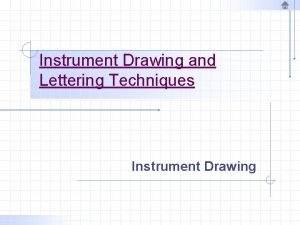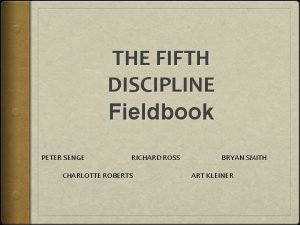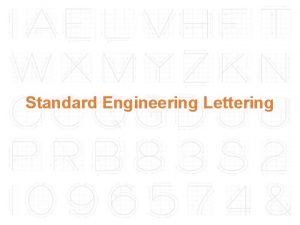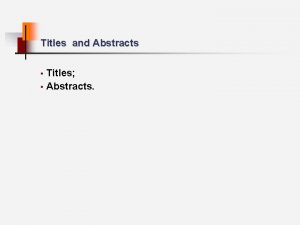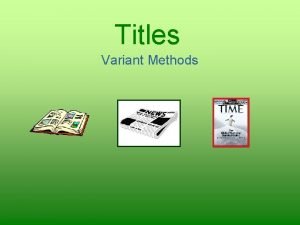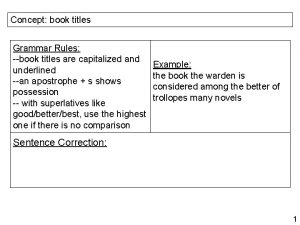LETTERING IS 9609 1990 Lettering Writing of Titles
















- Slides: 16

LETTERING (IS: 9609 – 1990) • Lettering: Writing of Titles, Dimensions, Notes and other particulars on a drawing, is called Lettering. • Single Stroke Letters: The thickness of line of letters should be such as is obtained in one stroke of pencil. It does not mean that the letter should be made in one stroke without lifting the pencil. Single stroke letters are of two types: 1. Vertical 2. Inclined– 75 degrees with horizontal. Proportions of lettering : Normal, Condensed, Extended Classifications: Gothic, Roman, Free hand


DIMENSIONS OF LETTERING CHARACTEERISTIC Lettering Height ‘A’ RATIO DIMENSIONS (mm) (d = h/14) Height of Capital Letters h (14/14) h 2. 5 3. 5 5 7 10 14 20 Height of Lower Case Letters c (10/14) h - 2. 5 3. 5 5 7 10 14 Spacing between Characters a (02/14) h 0. 35 0. 7 1 1. 4 2 2. 8 Minimum Spacing of Base Line b (20/14) h 3. 5 5 7 10 14 20 28 Minimum Spacing between Words e (06/14) h 1. 05 1. 5 2. 1 3 4. 2 6 8. 4 Thickness of Lines (01/14) h 0. 18 0. 25 0. 35 0. 7 1 1. 4 d

RECOMMENDED HEIGHTS OF LETTERS S. No. PURPOSE SIZE IN mm 1. Main Titles, Drawing Numbers 10 2. Subtitles 5 3. Dimensions and Notes 3

VERITCAL UPPERCASE LETTERS


VERTICAL LOWERCASE LETTERS

CONVENTION AND SYMBOL • THE REPRESENTATION OF ANY MATTER BY SOME SIGN OR MARK ON THE DRAWING IS KNOWN AS CONVENTION OR CODE OR SYMBOL. • DIFFERENT CONVENTIONS : A few of these are given below-1. Convention of Lines 2. Convention of Materials 3. Convention of Thread 4. Convention of Breaks 5. Convention of Surface Roughness

CONVENTION OF LINES

CONVENTION OF MATERIALS

IMPORTANCE OF DIMENSIONING 1. It expresses all sizes and other information necessary to define the object completely. 2. It must be done with due regard to manufacturing process and inspection requirements. 3. It includes expression of tolerances necessary for the correct functioning of the part given to be assembled. 4. Any discrepancy in shape or size can be checked.

• Two Types : 1. 2. TYPES OF DIMENSIONING Size Dimensioning Location Dimensioning

WAYS OF DIMENSIONING

SYSTEM OF DIMENSIONING

TYPES OF DIMENSIONING

PRINCIPLE OF DIMENSIONING OR GENERAL RULES OF DIMENSIONING 1. 2. 3. 4. 5. 6. 7. Dimensioning should be done so completely that further calculations or assumptions of any dimension, or direct measurement from the drawing is not necessary. Every dimension must be given, but none should be given more than once. A dimension should be placed on the view where its use is shown more clearly. Dimension should be placed outside the views, unless it is clearer and more easily read inside. Mutual cutting/crossing of dimension lines and dimensioning between hidden lines should be avoided. Dimension lines should not cross any other lines of drawing. An outline or a centre line should never be used as a dimension line. A centre line may be extended to serve as an extension line. Aligned system of dimensioning is recommended.
 1990 lettering
1990 lettering If the creditors financial claim to property totals $1 000
If the creditors financial claim to property totals $1 000 Jonathan and frances eduqas mark scheme
Jonathan and frances eduqas mark scheme Examples of cause and effect text structure
Examples of cause and effect text structure Modified-block style
Modified-block style Architectural lettering
Architectural lettering Tall man lettering چیست
Tall man lettering چیست Characteristics of lettering
Characteristics of lettering Types of lines in engineering drawing
Types of lines in engineering drawing Stairs one point perspective
Stairs one point perspective Lightly drawn lines used for lettering
Lightly drawn lines used for lettering Instrument drawing
Instrument drawing Moda 1990
Moda 1990 Peter senge 1990 the fifth discipline
Peter senge 1990 the fifth discipline Buss 1990
Buss 1990 Timeline of rap
Timeline of rap Introduction to microelectronic fabrication jaeger 1990
Introduction to microelectronic fabrication jaeger 1990











